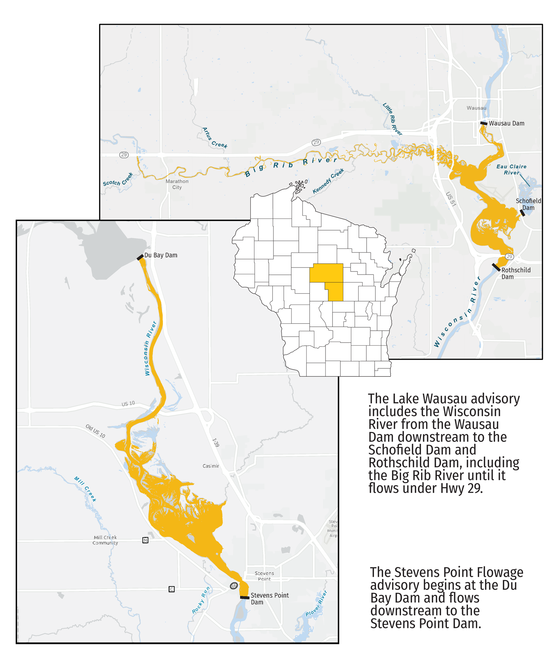MADISON, Wis. – The Wisconsin Department of Natural Resources (DNR) and the Department of Health Services (DHS) today announced a new PFAS-based consumption advisory for several fish species in Lake Wausau in Marathon County and the Stevens Point Flowage in Portage County (both of which are segments of the Wisconsin River) based on fish sampling.
Elevated levels of PFOS (perfluorooctane sulfonate), a type of PFAS (per- and polyfluoroalkyl substances), were found in several fish species sampled from both Lake Wausau and the Stevens Point Flowage.
As a result, the DNR and DHS recommend the following consumption guidelines for anyone harvesting fish from those waterbodies:
Lake Wausau (Marathon County): Advisory is from the Wausau Dam downstream to the Schofield Dam and Rothschild Dam, including the Big Rib River until it flows under Hwy 29.
| SPECIES | PREVIOUS ADVISORY | NEW ADVISORY |
| Black Crappie | General/Statewide* | 1 meal/week |
| Bluegill | General/Statewide* | 1 meal/week |
| Rock Bass | General/Statewide* | 1 meal/week |
| Yellow Perch | General/Statewide* | 1 meal/week |
| Common Carp | 1 meal/month (PCBs) | 1 meal/month (PCBs) (No Change) |
| Redhorse | 1 meal/month (PCBs) | 1 meal/month (PCBs) (No Change) |
Stevens Point Flowage (Portage County): Advisory begins at the Du Bay Dam and flows downstream to the Stevens Point Dam.
| SPECIES | PREVIOUS ADVISORY | NEW ADVISORY |
| Black Crappie | General /Statewide* | 1 meal/week |
| Bluegill | General /Statewide* | 1 meal/week |
| Rock Bass | General /Statewide* | 1 meal/week |
| Yellow Perch | General /Statewide* | 1 meal/week |
| Common Carp | 1 meal/month (PCBs) | 1 meal/month (PCBs) (No Change) |
| Redhorse | 1 meal/month (PCBs) | 1 meal/month (PCBs) (No Change) |
*The general/statewide consumption advice for women <50 and children is 1 meal/week for bluegill, crappies, yellow perch, sunfish, rock bass, bullheads and inland trout and 1 meal/month for all other species. For women >50 and men, the general/statewide consumption advice is 1 meal/week for all species except for bluegill, crappies, yellow perch, sunfish, rock bass, bullheads and inland trout, which are unrestricted.
PFAS are a group of human-made chemicals that have been used for decades in various products, such as non-stick cookware, fast food wrappers, stain-resistant sprays and certain types of firefighting foams that have made their way into the environment.
Health risks may increase when fish with high levels of PFAS are consumed. These can include increased cholesterol levels, decreased immune response, and decreased fertility in women, among other health effects. More information is available on the DHS website.
Following fish consumption advisories will help protect you from consuming excess PFOS, Polychlorinated Biphenyls (PCBs) and mercury. A complete list of up-to-date consumption advisories can be found in the DNR’s Choose Wisely booklet.
Additional fish consumption advice and information on the effects of PFAS can be found on the DNR’s website.




